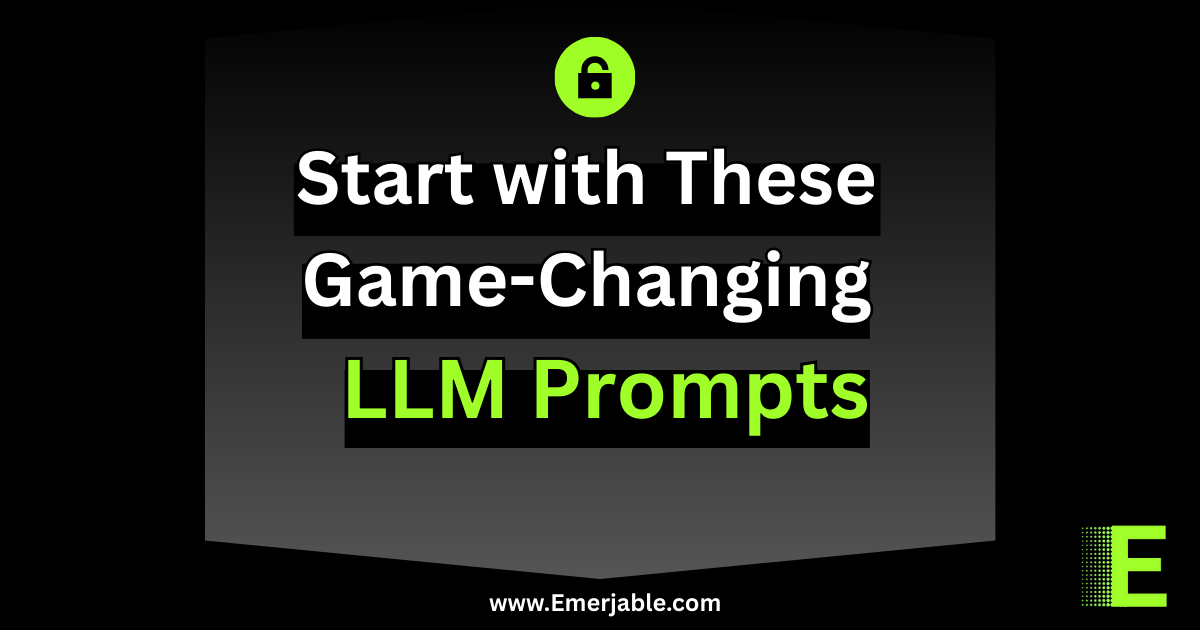Welcome to the exciting world of LLM Prompts! If you’ve ever marveled at how tools like ChatGPT, Claude, or Gemini can produce human-like content in seconds, you’re already familiar with the power of large language models (LLMs). But behind every impressive AI-generated response is one key ingredient: the prompt.
Whether you’re a curious beginner or an aspiring prompt engineer, this guide will walk you through everything you need to know to get started with AI prompts for beginners — from what a prompt is, to how to write effective ones, and practical examples you can start using today.
What is a Prompt in AI?
In simple terms, a prompt is the instruction or input you give to an AI model to generate a response. Think of it as the seed you plant — the more thoughtfully you plant it, the better the results you’ll grow.
For example:
- Prompt: “Write a short story about a robot who learns to love.”
- AI Response: A 300-word narrative complete with characters, conflict, and emotion.
Even minor tweaks to your prompt can lead to dramatically different outputs — making prompt crafting a vital skill.
Why Beginner LLM Prompts Matter
If you’re just getting started with LLMs, you might feel overwhelmed by all the possibilities. But here’s the good news: you don’t need a background in coding, data science, or AI to begin. The key is learning how to communicate with these tools clearly and effectively.
Beginner prompts help you:
- Understand how LLMs interpret instructions
- Explore content creation with AI safely and creatively
- Build confidence to create more advanced prompts over time
Types of LLM Prompts for Beginners
Let’s explore the most common beginner-friendly prompt types:
1. Instructional Prompts
Give the model a command.
- Example: “Explain photosynthesis in simple terms.”
2. Question-Based Prompts
Ask questions to get informative responses.
- Example: “What are the benefits of remote work?”
3. Completion Prompts
Start a sentence or paragraph and let the AI complete it.
- Example: “The future of education will be shaped by…”
4. Creative Prompts
Use AI for storytelling, poetry, and imaginative writing.
- Example: “Write a poem about a rainy day in Paris.”
5. Role-Based Prompts
Assign a role or persona to the AI for better context.
- Example: “You are a fitness coach. Create a 3-day beginner workout plan.”
The Ultimate Guide to Mastering Effective LLM Prompts for AI Text Generation
Basic Prompt Examples to Practice
To help you dive right in, here are some basic prompt examples categorized by purpose:
| Use Case | Prompt Example |
|---|---|
| Learning Topic | “Explain blockchain technology like I’m 12.” |
| Brainstorming Ideas | “Give me 5 blog post ideas about healthy eating.” |
| Writing Help | “Write an engaging introduction for an article on climate change.” |
| Social Media | “Create a witty tweet about morning coffee.” |
| Email Draft | “Draft a professional email requesting project status update.” |
How to Improve Your Prompts: Beginner Tips
Even basic prompts can be powerful if written well. Here’s how to take yours to the next level:
✅ Be Clear and Specific
Vague prompts lead to vague answers.
- Instead of: “Tell me about dogs.”
- Try: “Describe three popular dog breeds and their personalities.”
✅ Use Context
Add details for tailored responses.
- Example: “You are a travel agent. Recommend a 5-day itinerary in Japan for a couple who loves food and culture.”
✅ Set Format Expectations
Let the model know how you want the answer.
- Example: “List the pros and cons of electric cars in bullet points.”
✅ Experiment and Iterate
If the response isn’t what you expected, tweak the prompt and try again.
Getting Started with LLM Tools
You don’t need to install anything complex to begin. Here are a few popular platforms where you can try your beginner LLM prompts:
- ChatGPT (OpenAI)
- Claude (Anthropic)
- Gemini (Google)
- Microsoft Copilot
- Notion AI or Canva Magic Write
Many of these platforms offer free tiers, making it easy to experiment without any investment.
Common Mistakes Beginners Should Avoid
| Mistake | Fix |
|---|---|
| Too vague or broad prompts | Be more specific and clear about the goal. |
| Ignoring prompt structure | Use format cues (bullets, step-by-step, etc.) |
| Overloading with details | Focus the prompt on one clear outcome at a time |
| Not reviewing/editing outputs | Always review AI outputs for accuracy and tone |
Next Steps: Evolving Your Prompting Skills
Once you’ve mastered the basics, consider exploring:
- Prompt chaining: Using outputs from one prompt as inputs for another.
- Few-shot prompting: Providing examples to teach the model patterns.
- Role-playing prompts: Simulating interviews, customer service, or coaching.
Conclusion: Your AI Journey Starts with One Prompt
AI text generation isn’t just for developers or data scientists — it’s for you. With just a few well-crafted prompts, you can unlock powerful content creation, ideation, and productivity tools.
As you continue practicing with these AI prompts for beginners, you’ll gain more confidence and clarity in your communication with LLMs. The journey starts with a single prompt — where will you take it?



